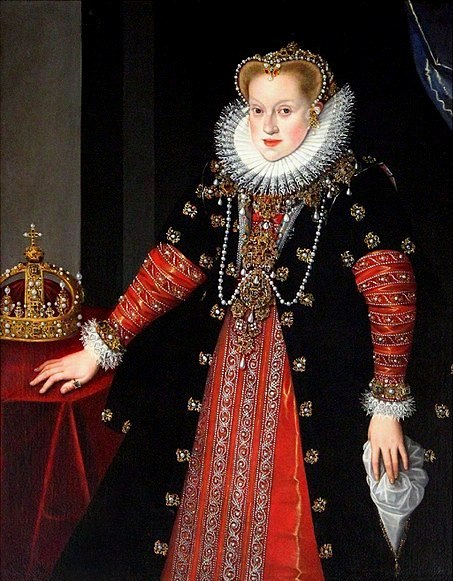Tags
Archduchess Anne of Austria, Archduke Charles II Franz of Austria, Holy Roman Emperor Ferdinand I, House of Habsburg, House of Vasa, Kingdom of Poland, Princess Maria Anna of Bavaria, Sigismund III of Poland and Sweden
Archduchess Anne of Austria (August 16, 1573 – February 10, 1598) was Queen of Poland and Sweden as the first consort of King Sigismund III Vasa.
Archduchess Anne was a daughter of Archduke Charles II Franz of Austria and ruler of Inner Austria (Styria, Carniola, Carinthia and Gorizia) from 1564. He was a member of the House of Habsburg. He was the third son of Ferdinand I, Holy Roman Emperor, and Anne of Bohemia and Hungary, daughter of King Vladislaus II of Hungary and his wife Anne of Foix-Candale.
Archduchess Anne’s mother was Maria Anna of Bavaria the daughter of Albrecht V, Duke of Bavaria and Archduchess Anna of Austria, the third of fifteen children of Holy Roman Emperor Ferdinand I (1503–1564) from his marriage with the Jagiellonian Princess Anna of Bohemia and Hungary (1503–1547).

Archduchess Anne’s mother was an important supporter of the Counter-Reformation in Inner Austria, who gave her children an upbringing focused on Catholicism.
The siblings were made to attend church from the age of one, their first words were to be Jesus and Mary, they were tutored by Catholic priests, and Latin was to be a priority before their native German language. As a child, Anna was called “Andle”, and she was taught to translate Ribadeneyra’s Vita Ignatii Loyolæ from Latin to German. Outside of Latin and Catholicism, she was mainly tutored in household tasks such as sewing and cooking.
Marriage
In 1577, the Papal envoy to Sweden, Possevino, suggested that the children of King Johan III of Sweden be married to children of the Habsburg dynasty. This was in a period when Sweden was close to a Counter-Reformation under Johan III and his Polish queen Catherine Jagiellon.
The Pope gave his approval to the idea of a marriage alliance between Habsburg and Sweden in the persons of Anne and Sigismund, as did the Polish king and queen, and when visiting Graz in 1578, Possevino acquired a portrait of Anne to bring with him on his next visit to the Swedish court.
Soon after, however, a new proposal was made to arrange a marriage between Anne and Henri of Lorraine to prevent French expansion in Lorraine, and for a while, these plans were given priority. In 1585, Anne accompanied her parents to the Imperial court in Vienna and Prague, unofficially to investigate a possible marriage to her cousin the Emperor, but those plans did not come to fruition either.
In 1586-1587, when Prince Sigismund of Sweden was elected King of Poland, his maternal aunt, Queen Anna Jagiellon, resummed the old plans of a marriage between Sigismund and Anne. Anne’s parents, however, still preferred the match with Henri of Lorraine, especially because of the political instability in Poland, the opposition of chancellor Jan Zamoisky and Archbishop Maximilian’s desire for the Polish crown.
In 1589, the Polish court opted for Maria Anna of Bavaria instead. In 1591, however, the Emperor finally decided that a marriage to Sigismund would be the match for Anne which would best benefit the Habsburg dynasty. Count Gustaf Brahe was sent as an envoy to Graz, other formalities were negotiated by Sigismund’s favorite cardinal Georg Radziwil, and Anne, who was personally unwilling, was told to obey the Emperor’s command.
In April 1592, the betrothal was formally celebrated in the Imperial Court in Vienna; on May 4, a proxy wedding was celebrated, after which Anna and her mother departed for the wedding in Krakow. Anne became the first wife of King Sigismund of Poland on May 31, 1592. This marriage was opposed by many szlachta (nobles) of the Polish–Lithuanian Commonwealth, who were opposed to the alliance with the Austrian Habsburgs that Sigismund pursued.
When Sigismund sent Cardinal Radziwill to Prague for his bride, the anti-Habsburg party with chancellor Jan Zamoyski guarded the borders to prevent the Archduchess from entering the country. Anne evaded the guards, arrived in Kraków, and was crowned in May 1592 by Primas Karnkowski as the Queen of Poland. Later, during her lifetime, the capital of the Commonwealth was moved from Kraków to Warsaw.
